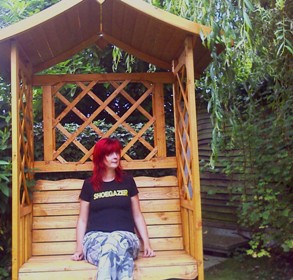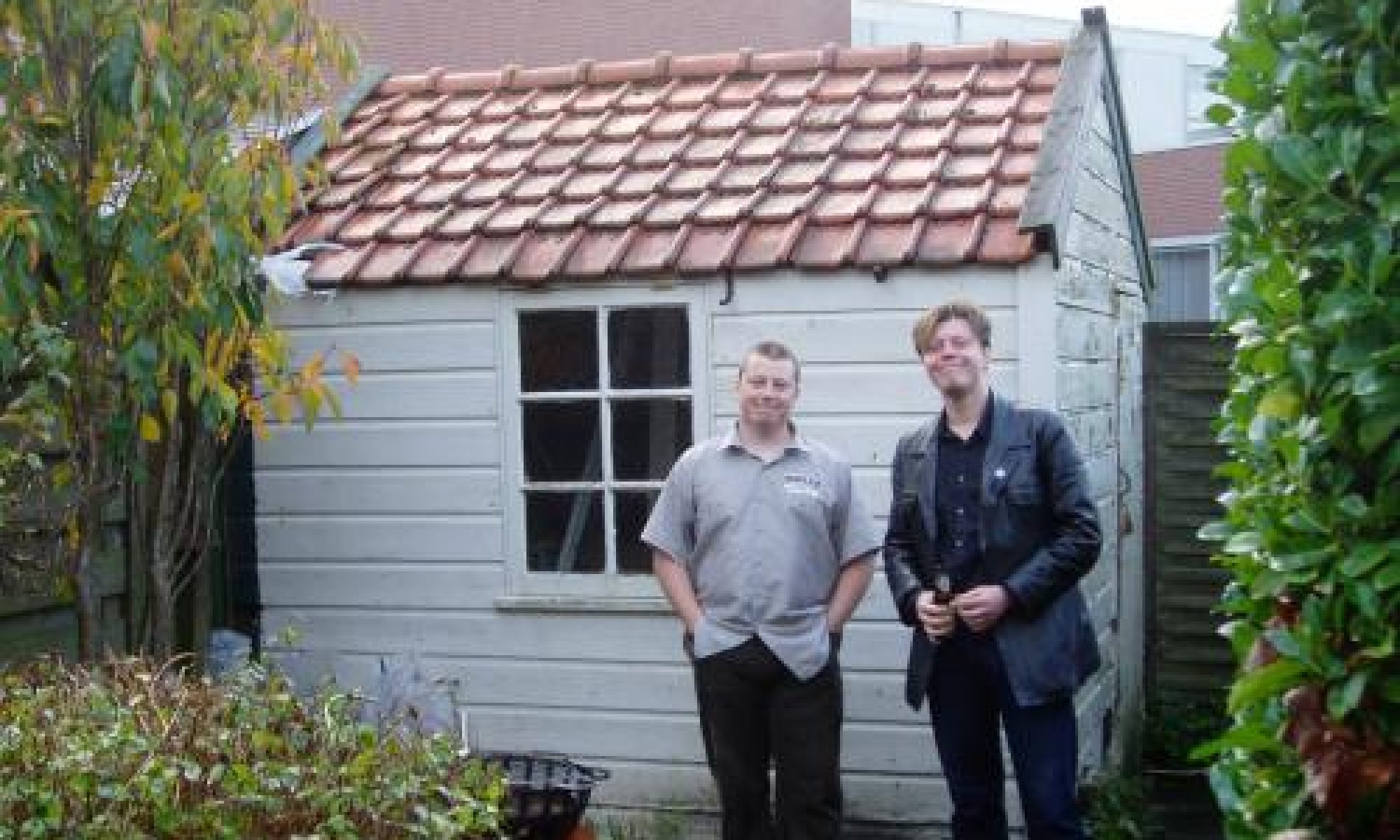But hang on, isn’t this – whisper it – shoegaze? And wasn’t that outlawed under the NME Fashion Police Act 1991?

Floreat Shoegaze!
September 2004, In The City, the busiest weekend of the year for a Manchester based music writer. By half way though day two I’ve seen so many Franz Ferdinand wannabes I want to grab hold of the next skittering hi-hat I hear and use it to do something extremely unsavoury to its owner. I fight my way though the braying industry liggers to the back room of Dry Bar, and within seconds I’m transported to another place entirely, a warm familiar place that feels like home – but a home I’ve not seen for a long time, and missed more than I ever realised.
The four skinny young men onstage are dressed in black, a couple of them hidden behind face-length hair. Their name is The Second Floor, and as I wrote at the time, “guitar distortion’s turned up as far as it will go – the set starts with a few minutes of white noise and only when ears are on the point of overload do they gradually introduce tune and rhythm. Next up are Barnsley‘s Lycasleep – “their bodies and long hair are string-thin, standing motionless silhouette-like in the red-lit glow. Delay-soaked guitar lines drift in and out on some solar wind, as the singer mouths barely perceptible shamanic whispers.” It wasn’t, if I’m being honest, the first time I had seen either band – but both bands absolutely blow me away this time and seeing them here one after another feels like the birth pangs of something special. But hang on, isn’t this – whisper it – shoegaze? And wasn’t that outlawed under the NME Fashion Police Act 1991?
The summer of 1991 had seen the end of my first year at university and I had failed all my exams after deciding that following Sonic Boom’s first solo tour around the country. (I passed second time around, and wouldn’t change a thing). I saw them all – the splinters of my beloved Spacemen 3 in the form of Spectrum, Spiritualized and The Darkside; the big three from the Home Counties, Ride, Chapterhouse and Slowdive; the second tier from the vastly underrated Swervedriver to the rather average Revolver; and one of the few Northern representatives, Leeds-based Pale Saints. (My hometown was still in recovery from the previous couple of summers’ raving, and didn’t contribute a great deal).
A summer job put proper money in my hand for the first time and I amassed quite a collection of twelve inch vinyl albums with the requisite left-field still-life sleeves, and still had enough left for a ticket to Reading Festival where many of my beloved bands were on the bill…
And then, suddenly, it was all over. The American invasion force came from nowhere, its first strike right there, at the heart of shoegazing’s Thames Valley. Its name was Nirvana, and their incendiary set that weekend turned thousands of kids into plaid-uniformed grunge worshippers overnight, leaving the very British Chapterhouse to play their immediately following slot to a depleted and disinterested crowd. Well, that’s what the history books say, anyway – but isn’t history always written by the victors? That’s not actually quite how I remember it.
Neither band was the best in their respective genre; Nirvana to me were at that point just a poor man’s Mudhoney (I loved the shoegaze bands but my taste was never limited to them) and Chapterhouse – despite one or two brilliant songs – Ride’s understudies. Both played decent enough sets. Most people round where I was standing stayed put. That, however, doesn’t make particularly great copy for a music press desperate to kill off a scene they’d got bored with so they could salivate over their new fixation. Openly admitting to being a Slowdive fan was suddenly on a level with openly admitting you had leprosy, although slightly less socially acceptable.
Years later, in early 2005, the lead guitarist of a popular indie band confessed to me a secret love of the scene which had long since stopped celebrating itself. The NME was still slagging off anyone vaguely related to shoegazing even by this point, but the assembled crowd – some having come from as far afield as Madrid – in Dry Bar that afternoon in 2004 knew better.
There were others. Literally days later, from East Anglia came a demo for review, a new band called Sennen, and one listen strongly implied to me it was the Ride B-side (one of my favourites of theirs) as opposed to a small area of Cornwall which inspired the name. Spacemen 3 and My Bloody Valentine gradually ceased to be, in the eyes of lazy journalists, “the band Spiritualized’s Jason Pierce started out in” and “the band who nearly killed Creation Records” and instead started to acquire tags such as “seminal”, “pioneering” and “influential”. Elsewhere the likes of Ulrich Schnauss and then Maps were taking the spirit and sounds of the shoegaze era and mixing them up with techno and electronica; I can’t have been the only first-wave shoegaze fan driven into rave and techno clubs by the sorry state of guitar music in the mid-90s who found this the most exciting musical development for years.
And somewhere in the south of England was born Sonic Cathedral, a club night and subsequently record label promoting this new generation alongside alumni of the first. When the night eventually made the trip up north in early 2007, its first notes were rightfully struck by The Second Floor. Down the front at a Night & Day impressively full for a Sunday night in February I felt an overwhelming sense of pride that this band I had championed in the local music press for two and a half years, and the music I and clearly many others loved, was at last getting its due recognition.
Minutes later I saw Maps play live for the first time and they blew my head off (almost literally, actually, due to an exploding percussion item); the summer brought the glorious surprise that the stunning debut album We Can Create – which had at that point never left my stereo since the day it came out – had found itself nominated for the Mercury Prize. Was the rest of the world finally starting to catch up? News of Slowdive reissues brought unexpectedly good reviews as the traditional music press finally relented on its effective embargo. In the grand tradition of movements reclaiming derogatory terms to wear as a badge of pride, Sonic Cathedral produced T-shirts bearing the word “Shoegazer” in block capitals. Then came the whispers, My Bloody Valentine were getting back together…
Neither of those two bands from that hazy 2004 afternoon is still with us – trailblazers who burnt out before their time. Some of Lycasleep now play in Exit Calm, tipped for great things not just in traditional spacerock/shoegaze circles but by sources as unexpected as The Sun newspaper and Tom Clarke from NME favourites The Enemy. And The Second Floor’s Nolan Watkinson resurfaced in June 2008, playing bass in Sonic Boom’s latest incarnation of Spectrum. And suddenly, over the course of four weeks or so, this revival that had been slowly building over the past four years and gathering pace since last summer, exploded overground in a glorious coming together of the old and the new.
Spectrum supported My Bloody Valentine on their reunion tour, and over the two nights at Manchester Apollo I lost count of the number of members of other bands in the crowd, most not old enough to have seen the legends before. I had, but this was something else. The feedback break was like nothing I have experienced in many years of gig going; standing in front of the speaker was like being in a wind tunnel as the sheer force of the sound blew people’s hair around. At the end a friend who’s just finished his first year at university, the age I was in that long ago summer of 91, was so blown away he could hardly form words.
Two weeks later, Oxfordshire’s Truck Festival turned its indoor stage over to Sonic Cathedral for one day. The almost criminally young and fresh-faced Kyte created walls of sound worthy of all manner of flowery prose, The Early Years sounded more like Spacemen 3 than Spacemen 3 ever did (with a side order of Faust and Suicide), Spectrum threw in some Spacemen classics, and Ulrich Schnauss proved you don’t even need guitars these days to create the perfect dreampop soundscapes. The headline set by Maps remains one of the single greatest musical performances I have seen this year. At the end, as Ulrich Schnauss returned to join them stage, a long lost old friend of an unmistakeable bassline emerged from the beautiful mass of electronics and guitars: an outstanding 21st century take on Ride’s Leave Them All Behind, the sound of past, present and future colliding.
After that, the secret special guests were a bit of an anticlimax – a lot of the crowd had got the idea into their heads it was going to be Ride, and whilst I was aware that it wasn’t, as I said earlier, despite one or two brilliant songs I always considered Chapterhouse to be Ride’s understudies. And they didn’t even do the brilliant songs. No matter. Five years ago they’d have been lucky to get a booking at their local.
The Ride reunion surely can’t be that far off – word has it Mark Gardener and Andy Bell are talking again, (no way – Ed) although Bell would need to arrange time off from the day job in Oasis. The “lead guitarist of a popular indie band” and secret shoegazer I mentioned a few paragraphs back was Martin Noble of British Sea Power; the band’s 2008 album Do You Like Rock Music sees Noble’s first solo songwriting credit, a beautiful, sweeping echo-drenched instrumental which sounds like something Ride might have put out in 1991. It’s widely regarded amongst their fans as the high point of their current live set.
The Verve’s reunion performances showed a clear acknowledgement of their space-dream beginnings; at the time of writing Forth has just crashed into the charts at number one. I quite like it, but Sennen’s recently released second album Where The Light Gets In is far better. About a year ago I was rummaging in the back of a cupboard, looking for something else, when I pulled out a perfectly preserved Breton striped fisherman’s top – the shirt of choice for many a shoegazer back in the day, it seemed to have avoided attack from moths or mildew over the intervening years – and I’ve been wearing it with pride ever since.
Cath Aubergine 2008
